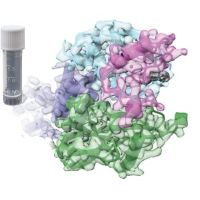Specification
| Description | Recombinant protein from the full-length sequence of homo sapiens cullin 4A (CUL4A), transcript variant 2 (NM_003589). |
| Organism | Homo sapiens (Human) |
| Expression Host | Human Cells |
| Tag Info | His or DYKDDDDK. Please contact us if you need further information or require specific designed tag. |
| Purity | Greater than 90% by SDS-PAGE gel |
| Uniprot ID | Q13619 |
| Entry Name | CUL4A_HUMAN |
| Gene Names | CUL4A |
| Alternative Gene Names | |
| Alternative Protein Names | Cullin-4A (CUL-4A) |
| Application | Antigens, Western, ELISA and other in vitro binding or in vivo functional assays, and protein-protein interaction studies; For research & development use only! |
| Buffer | Purified protein formulated in a sterile solution of PBS buffer, pH7.2, without any preservatives |
| Endotoxin | Endotoxin level is < 0.1 ng/µg of protein (<1EU /µg) |
| Length | 759 |
| Molecular Weight(Da) | 87680 |
| Protein Sequence | (The sequence of expressed protein may have some variation from the sequence shown below. Please contact us for the exact sequence.) MADEAPRKGSFSALVGRTNGLTKPAALAAAPAKPGGAGGSKKLVIKNFRDRPRLPDNYTQDTWRKLHEAVRAVQSSTSIRYNLEELYQAVENLCSHKVSPMLYKQLRQACEDHVQAQILPFREDSLDSVLFLKKINTCWQDHCRQMIMIRSIFLFLDRTYVLQNSTLPSIWDMGLELFRTHIISDKMVQSKTIDGILLLIERERSGEAVDRSLLRSLLGMLSDLQVYKDSFELKFLEETNCLYAAEGQRLMQEREVPEYLNHVSKRLEEEGDRVITYLDHSTQKPLIACVEKQLLGEHLTAILQKGLDHLLDENRVPDLAQMYQLFSRVRGGQQALLQHWSEYIKTFGTAIVINPEKDKDMVQDLLDFKDKVDHVIEVCFQKNERFVNLMKESFETFINKRPNKPAELIAKHVDSKLRAGNKEATDEELERTLDKIMILFRFIHGKDVFEAFYKKDLAKRLLVGKSASVDAEKSMLSKLKHECGAAFTSKLEGMFKDMELSKDIMVHFKQHMQNQSDSGPIDLTVNILTMGYWPTYTPMEVHLTPEMIKLQEVFKAFYLGKHSGRKLQWQTTLGHAVLKAEFKEGKKEFQVSLFQTLVLLMFNEGDGFSFEEIKMATGIEDSELRRTLQSLACGKARVLIKSPKGKEVEDGDKFIFNGEFKHKLFRIKINQIQMKETVEEQVSTTERVFQDRQYQIDAAIVRIMKMRKTLGHNLLVSELYNQLKFPVKPGDLKKRIESLIDRDYMERDKDNPNQYHYVA |
Background
| Function | FUNCTION: Core component of multiple cullin-RING-based E3 ubiquitin-protein ligase complexes which mediate the ubiquitination of target proteins (PubMed:14578910, PubMed:15811626, PubMed:15548678, PubMed:15448697, PubMed:14739464, PubMed:16678110, PubMed:17041588, PubMed:24209620, PubMed:30166453, PubMed:33854232, PubMed:33854239). As a scaffold protein may contribute to catalysis through positioning of the substrate and the ubiquitin-conjugating enzyme (PubMed:14578910, PubMed:15811626, PubMed:15548678, PubMed:15448697, PubMed:14739464, PubMed:16678110, PubMed:17041588, PubMed:24209620). The E3 ubiquitin-protein ligase activity of the complex is dependent on the neddylation of the cullin subunit and is inhibited by the association of the deneddylated cullin subunit with TIP120A/CAND1 (PubMed:14578910, PubMed:15811626, PubMed:15548678, PubMed:15448697, PubMed:14739464, PubMed:16678110, PubMed:17041588, PubMed:24209620). The functional specificity of the E3 ubiquitin-protein ligase complex depends on the variable substrate recognition component (PubMed:14578910, PubMed:15811626, PubMed:15548678, PubMed:15448697, PubMed:14739464, PubMed:16678110, PubMed:17041588, PubMed:24209620). DCX(DET1-COP1) directs ubiquitination of JUN (PubMed:14739464). DCX(DDB2) directs ubiquitination of XPC (PubMed:15811626). DCX(DDB2) ubiquitinates histones H3-H4 and is required for efficient histone deposition during replication-coupled (H3.1) and replication-independent (H3.3) nucleosome assembly, probably by facilitating the transfer of H3 from ASF1A/ASF1B to other chaperones involved in histone deposition (PubMed:16678110, PubMed:17041588, PubMed:24209620). DCX(DTL) plays a role in PCNA-dependent polyubiquitination of CDT1 and MDM2-dependent ubiquitination of p53/TP53 in response to radiation-induced DNA damage and during DNA replication (PubMed:14578910, PubMed:15548678, PubMed:15448697). DCX(DTL) directs autoubiquitination of DTL (PubMed:23478445). In association with DDB1 and SKP2 probably is involved in ubiquitination of CDKN1B/p27kip (PubMed:16537899). Is involved in ubiquitination of HOXA9 (PubMed:14609952). The DDB1-CUL4A-DTL E3 ligase complex regulates the circadian clock function by mediating the ubiquitination and degradation of CRY1 (PubMed:26431207). A number of DCX complexes (containing either TRPC4AP or DCAF12 as substrate-recognition component) are part of the DesCEND (destruction via C-end degrons) pathway, which recognizes a C-degron located at the extreme C terminus of target proteins, leading to their ubiquitination and degradation (PubMed:29779948). The DCX(AMBRA1) complex is a master regulator of the transition from G1 to S cell phase by mediating ubiquitination of phosphorylated cyclin-D (CCND1, CCND2 and CCND3) (PubMed:33854232, PubMed:33854239). The DCX(AMBRA1) complex also acts as a regulator of Cul5-RING (CRL5) E3 ubiquitin-protein ligase complexes by mediating ubiquitination and degradation of Elongin-C (ELOC) component of CRL5 complexes (PubMed:30166453). With CUL4B, contributes to ribosome biogenesis (PubMed:26711351). {ECO:0000269|PubMed:14578910, ECO:0000269|PubMed:14609952, ECO:0000269|PubMed:14739464, ECO:0000269|PubMed:15448697, ECO:0000269|PubMed:15548678, ECO:0000269|PubMed:15811626, ECO:0000269|PubMed:16537899, ECO:0000269|PubMed:16678110, ECO:0000269|PubMed:17041588, ECO:0000269|PubMed:23478445, ECO:0000269|PubMed:24209620, ECO:0000269|PubMed:26431207, ECO:0000269|PubMed:26711351, ECO:0000269|PubMed:29779948, ECO:0000269|PubMed:30166453, ECO:0000269|PubMed:33854232, ECO:0000269|PubMed:33854239}. |
| Pathway | Protein modification; protein ubiquitination. |
| Protein Families | Cullin family |
| Tissue Specificity |
QC Data
| Note | Please contact us for QC Data |
| Product Image (Reference Only) |  |

